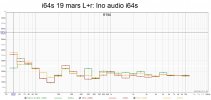OP
- Thread Starter
- #101
Well that explains it! Not the part about me being amazing, but the part about you having a heavily damped room with 26 additional speakers for artificial reverb. That's amazing.You are amazing! I think you are right about the bass. I probably did the sweep above 100 Hz. The room is very much damped as I use variable reverberation via 26 additional speakers. The RT60 can go higher than 4s.
So the measurements can vary depending on the reverbs like here



